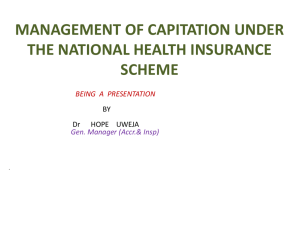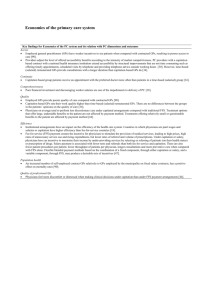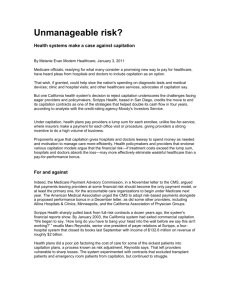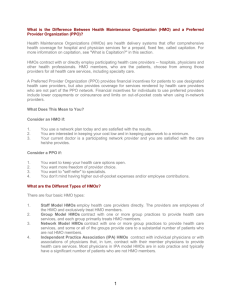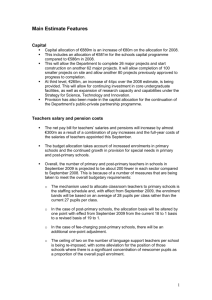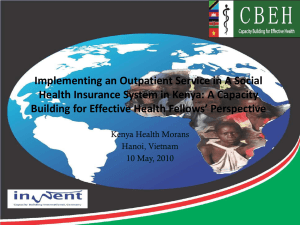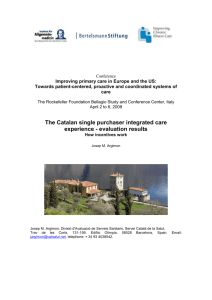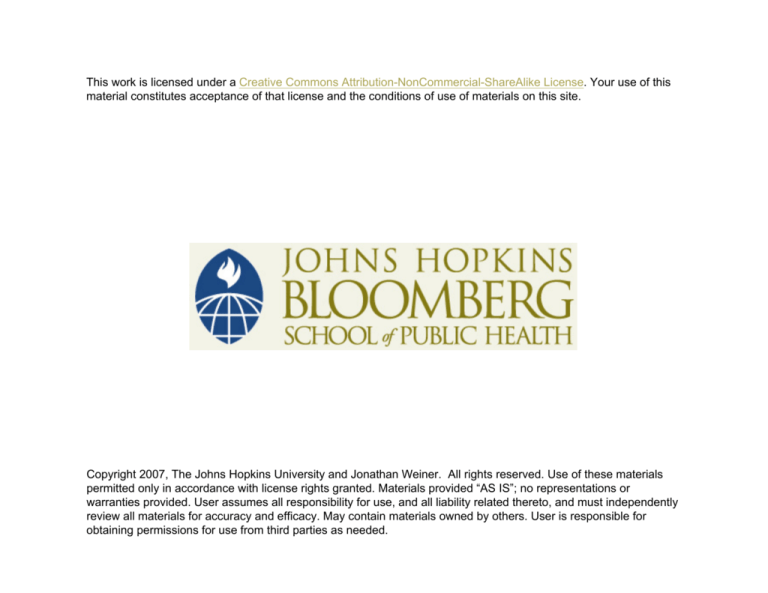
This work is licensed under a Creative Commons Attribution-NonCommercial-ShareAlike License. Your use of this
material constitutes acceptance of that license and the conditions of use of materials on this site.
Copyright 2007, The Johns Hopkins University and Jonathan Weiner. All rights reserved. Use of these materials
permitted only in accordance with license rights granted. Materials provided “AS IS”; no representations or
warranties provided. User assumes all responsibility for use, and all liability related thereto, and must independently
review all materials for accuracy and efficacy. May contain materials owned by others. User is responsible for
obtaining permissions for use from third parties as needed.
Session 3
Risk, Capitation, and
Other Financial Issues
in Managed Care
Jonathan P. Weiner, Dr. P.H.
Professor or Health Policy & Management
Health Care Financing and
Coverage in the US
Private Ins.
Population
67%
Payment
44%
Medicare
10
16
Medicaid
9
14
14
-
16
10
Uninsured
Out-of -Pocket
Other
3
Who is “At Risk” For Cost of
Care Provision
30%
Self-insured employers
25%
For-profit MCOs
- 5% Gov. contracts
- 18% Empl. contracts
20% Not-for-profit MCOs/IDSs
13% For uninsured: safety net providers,
government, patient
12% Government programs
4
Capitation: A Working
Definition
A type of health care financing where
a provider is paid a fixed per-capita
fee for a pre-negotiated market basket
of services on behalf of an enrolled
group of consumers.
5
Potential Advantages of Capitation
• Strong incentives for efficiency
• Fosters primary care and
prevention
• Fosters “population orientation”
6
Potential Disadvantages of Capitation
• Could offer incentives to skimp
• Incentives to avoid sick
consumers
• Individual Patient and provider
choices may be limited
7
Avg % of HMO “Contracts” Reimbursed via
Capitation by Provider Type (2005)
Percentage of Contracts
80%
60%
58.0%
39.0%
40%
31.0%
20%
0%
PCP
Source: Aventis 2006
Specialist
Hospital
8
METHODS OF PHYSICIAN
REIMBURSEMENT BY HMO TYPE (2005)
SALARY
FEE-FOR
SERVICE
BONUS
PROGRAM
CAPITATION
HMO Type
IPA
NETWORK
Group
Staff
4%
3
13
89
69%
72
57
56
10%
15
17
22
74%
73
80
67
OVERALL
7%
68%
13%
74%
Source: Aventis 2006
9
How Physicians Will Be Paid
Share of Practice Revenue That Will Come From
Different Payment Schemes
Capitation/prospective payment
Discounted fee-for-service payment
Performance-based mechanisms
Fee-for-service payment (including Medicare)
40%
30%
20%
10%
0%
2002
2007
Source: Health & Health Care 2010: The Forecast,the Challenge. Institute For The Future, Menlo
Park, CA, 2000
2010
10
ABC Health Plan (Simplified) Premium Rate Development
Spreadsheet for 2006
Utilization
per 1000
INPATIENT
Medical/Surgical
ICU/CCU/NNU
Maternity
Mental Health
Nursery
Subtotal
PRIMARY CARE
Office visits
Immunizations
Other
Subtotal
SPECIALTY CARE
Surgeries
Medical Specialist
Radiologist
Lab
Obstetrics
Psychiatric Care
DME
Physical Tx
Subtotal
OUTPATIENT OTHER
Amb Surgery
ER
Ambulance
Subtotal
Unit
Cost
190
30
45
15
20
300
$1,200
2,300
1,350
650
700
4200
440
1200
5840
$ 35
30
15
80
650
900
2600
35
160
40
140
4605
$ 1400
100
60
19
2200
60
150
60
70
200
50
320
$ 1800
280
120
PMPM
Cost
19.00
5.75
5.06
0.81
1.17
Co-Ins.
Adjust
0.57
0.17
0.15
0.02
0.04
Adjusted
Cost
Cum.
Total
18.43
5.58
4.91
0.79
1.13
$ 30.84
12.25
1.10
1.50
1.75
10.50
1.10
1.50
$13.10
9.33
5.42
4.50
4.12
6.42
0.80
0.50
0.70
0.08
9.33
5.42
4.50
4.12
6.42
0.80
0.42
0.70
$31.70
10.50
4.67
0.50
10.50
4.67
0.50
$ 15.67
TOTAL MEDICAL EXPENSE
91.31
Administrative / Care Management
Targeted Profit/Reserve
24.00
8.00
Total Required Revenue
$123.31
Employer
Consumer
Government
Typical Network HMO
Financial Arrangement
Pharmacies
or PBM
HMO
Pharmacy Fund
Reserve
Fund
***
**
Institutional Referral Fund
Primary Care
Fund
20%
Withhold
Fund
80%
*
Hospital
Specialists
* only if IRF surplus
** If expenses > stop loss
*** if fund is overexpended
Primary Care
Group Practice
6
Financial Management
Definitions
•
PMPM - Per member per month. Specifically applies
to a revenue or cost for each enrolled member each
month.
•
Medical loss ratio =
(Medical Expenses/Premium)
•
IBNR - Incurred but not reported. Medical expenses
about which the plan does not yet know.
13
Definitions – Cont.
Stop Loss: a form of reinsurance that provides
protection for medical expenses above a certain
limit, generally on a year-by-year basis. It may
apply to an entire health plan or to a single
component.
14
Risk Adjusted Capitation
Payment
Risk adjusters redistribute dollars among
health plans based upon the expected
health status of the enrolled population in
each health plan.
15
Why Risk Adjustment is
Needed
% US Population
% of Health Care $
1%
30%
10%
72%
50%
97%
16
Why Risk Adjusted Payment is
Necessary
• To deter plans from selecting or marketing to
healthier enrollees
• To protect plans from being selected by a
costlier than average group of enrollees
• To facilitate plan’s attempts to specialize in
treating people with certain illnesses or
conditions
17
Methods of Risk Adjusted
Payment
•
Reinsurance thresholds
• Prospective capitation
adjuster
•
High cost carve-outs
18
“Johns Hopkins ACG” Risk
Adjustment/ Case-Mix
Methodology
“Adjusted Clinical Groups”, formerly
Ambulatory Care Groups
See: www.acg.jhsph.edu
20
ACGs Lead to Fairer Payments
A comparison of demographic-based and ACG-based capitation
payments to actual expenditures for healthier-than-average and
sicker-than-average enrollee groups showed that ACG-based
payments are much closer to actual expenditures:
Group Type
Sicker than
average
Payment
system
Demographic
ACG
Healthier than
Average
Demographic
ACG
Source: JAMA, 10/23/96
Difference from
“perfect payment
5.2%
underpayment
0.7%
overpayment
7.9%
overpayment
0.6%
underpayment
21
Other Non-Payment Applications of
Risk Adjustment
• Adjusting Performance (quality and
efficiency) “ Profiles”
• “Predictive Modeling” to identify high
risk cases for Care / Disease
Management
• Control and Stratification for
Analysis, Evaluation, & Research
22


